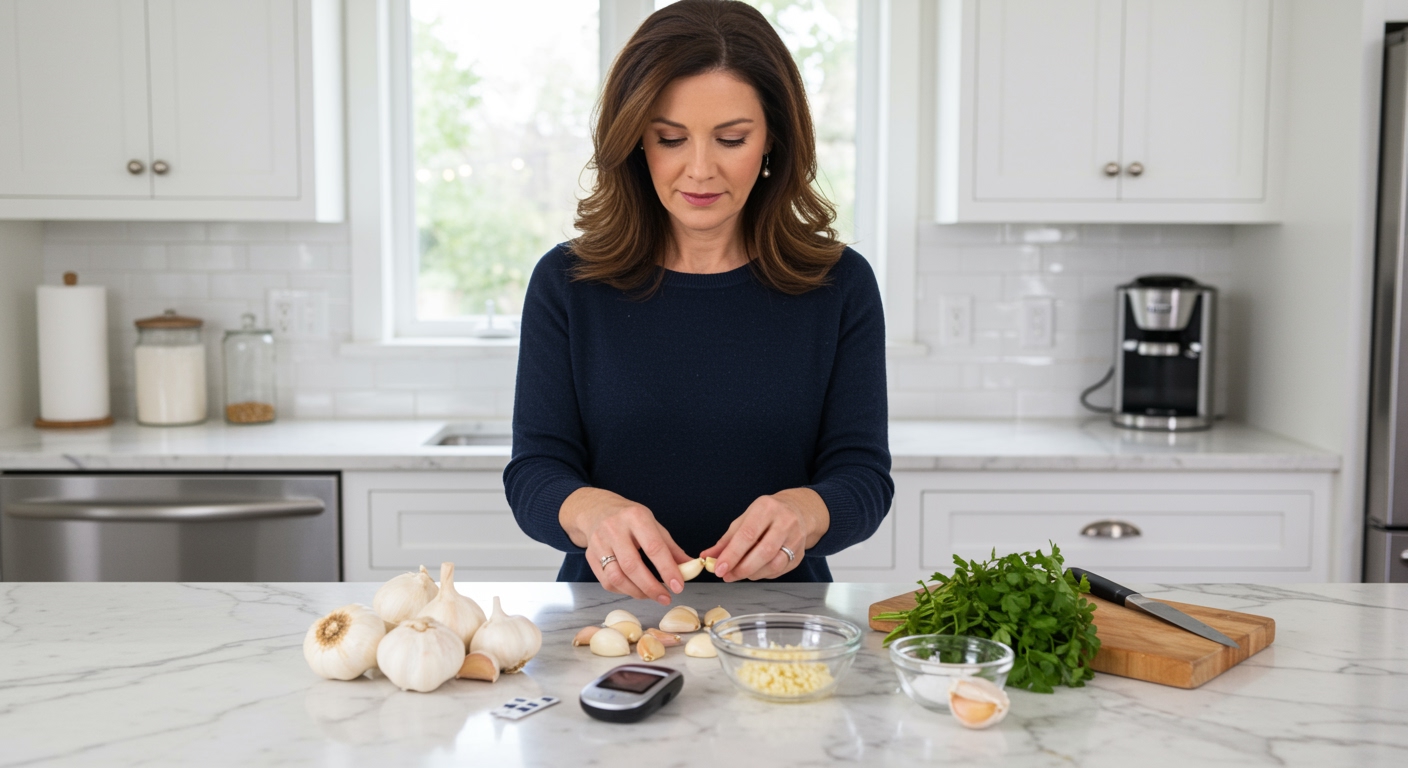✪ Key Takeaway: Garlic can help lower blood sugar levels through compounds like allicin that improve insulin sensitivity and glucose metabolism.
Introduction
Your grandmother probably told you garlic keeps away evil spirits, but she never mentioned it might keep away high blood sugar too.
You might be wondering about garlic because you heard someone mention it helps with diabetes, or maybe your doctor suggested looking into natural ways to support your blood sugar management.
Hi, I’m Abdur, your nutrition coach, and today I’m going to explain exactly how garlic affects your blood sugar and whether this kitchen staple deserves a spot in your diabetes management plan.
How Does Garlic Actually Work Against High Blood Sugar?
Garlic contains over 100 sulfur compounds, but the star player is allicin.
When you crush or chop fresh garlic, an enzyme called alliinase converts alliin into allicin.
This allicin works like a key that unlocks your cells to let glucose enter more easily.
Research shows allicin increases insulin sensitivity by activating specific proteins in your muscle and liver cells.
Your pancreas also benefits because garlic compounds protect the beta cells that produce insulin from damage caused by high blood sugar.
Think of garlic as a cellular mechanic that helps repair and maintain your body’s blood sugar control system.
✪ Pro Tip: Crush garlic and let it sit for 10 minutes before cooking to maximize allicin formation.
What Do The Studies Actually Show About Garlic And Diabetes?
Multiple clinical trials have tested garlic’s effects on blood sugar with promising results.
A systematic review of studies found that garlic supplementation reduced fasting blood glucose by an average of 15-20 mg/dL in people with diabetes.
One study gave participants 300mg of garlic extract twice daily for 12 weeks.
The results showed significant improvements in both fasting glucose and HbA1c levels compared to the placebo group.
Another research project followed people with type 2 diabetes who ate fresh garlic daily for 8 weeks.
Their average blood sugar dropped by 12 percent, and their insulin sensitivity improved by 18 percent.
These studies used different forms of garlic, from fresh cloves to aged extracts, and most showed measurable benefits.
✪ Fact: Studies typically used 600-1200mg of garlic extract daily, equivalent to 2-4 fresh cloves.
How Much Garlic Should You Eat For Blood Sugar Benefits?
The effective dose varies depending on whether you use fresh garlic or supplements.
Most successful studies used the equivalent of 2-4 fresh garlic cloves daily.
One medium garlic clove weighs about 3 grams and contains roughly 300mg of active compounds.
If you prefer supplements, look for products that provide 600-1200mg of standardized garlic extract daily.
Fresh garlic works better than cooked garlic because heat destroys some of the beneficial compounds.
You can add raw minced garlic to salads, mix it into yogurt, or swallow small pieces like natural pills.
Start with one clove daily and gradually increase to avoid digestive upset or strong breath.
✪ Note: Aged garlic extract supplements may cause less digestive irritation than fresh garlic.
Are There Any Risks Or Side Effects You Should Know About?
Garlic is generally safe for most people, but it can cause some unwanted effects.
The most common side effects include bad breath, body odor, and stomach upset.
Garlic acts as a natural blood thinner, so it may increase bleeding risk if you take anticoagulant medications.
People scheduled for surgery should stop eating large amounts of garlic at least two weeks beforehand.
If you take diabetes medications, monitor your blood sugar more frequently when adding garlic because it might enhance their effects.
Some people experience heartburn or digestive irritation, especially when eating raw garlic on an empty stomach.
Always discuss significant dietary changes with your healthcare provider, particularly if you have multiple health conditions.
✪ Pro Tip: Take garlic with food to reduce stomach irritation and drink milk to neutralize strong breath.
What Are The Best Ways To Add Garlic To Your Diabetes Diet?
Smart garlic use means maximizing benefits while minimizing digestive discomfort.
Mix minced raw garlic into homemade salad dressings with olive oil and lemon juice.
Add crushed garlic to vegetable soups during the last few minutes of cooking to preserve active compounds.
Create garlic-infused oils by letting crushed cloves sit in olive oil for several hours, then strain.
Spread minced garlic on whole grain toast with avocado for a blood sugar friendly snack.
Make garlic paste by blending fresh cloves with a small amount of water, then freeze in ice cube trays for easy portioning.
Remember that consistency matters more than large amounts, so aim for daily inclusion rather than occasional mega-doses.
✪ Fact: Combining garlic with onions may provide additional blood sugar benefits due to similar sulfur compounds.
The Bottom Line
Garlic shows genuine promise as a natural tool for supporting healthy blood sugar levels, backed by multiple scientific studies and centuries of traditional use.
The best medicine often grows in your garden, not just in a pharmacy, and garlic proves this wisdom holds true for blood sugar management.
I would love to hear about your experiences with garlic and blood sugar management, or any questions you might have about incorporating this powerful bulb into your daily routine, so please share your thoughts in the comments below.
References
At NutritionCrown, we use quality and credible sources to ensure our content is accurate and trustworthy. Below are the sources referenced in creating this article:
- PMC: Garlic and Diabetes: A Comprehensive Review
- Asia Pacific Journal of Clinical Nutrition: Effects of Garlic on Blood Glucose
- Systematic Reviews in Pharmacy: Clinical Trials on Role of Garlic in Managing Diabetes
- Core Academic: Garlic Supplementation and Metabolic Parameters





